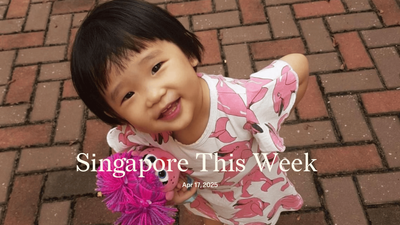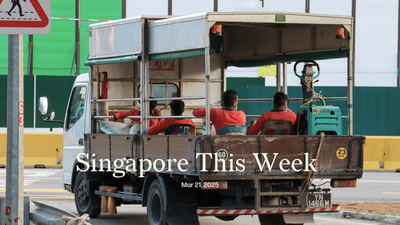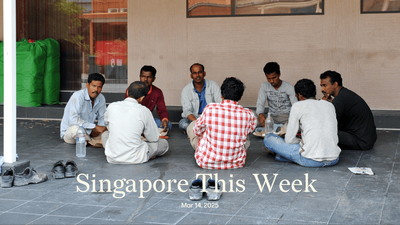Politics: Hound the family, too
The National University of Singapore (NUS) allegedly invited and then uninvited an academic for a conference here next January. No explanation was given to Sol Iglesias, an assistant professor of political science at the University of the Philippines (Diliman), who was to be one of three speakers on a panel discussing South-east Asian perspectives on “Public Intellectuals, Populism and Power”. In June, the panel’s convenor told her it was confirmed; in August, they discussed travel logistics; and then on November 2nd, they informed her that “higher ups” had scuppered the plan. Why? Her host speculated, Sol wrote in a Medium post, that it was because of the identity of her husband: PJ Thum, an Oxford-trained historian and co-founder of New Naratif, who’s in recent years become a thorn in the side of the ruling People’s Action Party (PAP). (Aaron Thean, NUS’s provost, and Lionel Wee, dean of the faculty of arts and social sciences, did not return a request for comment.) It’s not altogether surprising. Singaporean academics such as Cherian George and Donald Low have faced similar blockades in the past. Meanwhile, 38.9 percent of academics surveyed in 2021 by Academia.sg, which is co-run by George, said that they did not feel free to invite guest speakers as they wished. Those who considered their research politically sensitive were 1.5-3.5 times more likely to feel constrained in their work, as compared to researchers in non-sensitive areas. Did somebody senior actually send down an order barring Iglesias? Or did a lowly bureaucrat self censor in order to “cover backside”? In Singapore, like in other illiberal democracies, it’s never quite clear from whom repression emanates. In “The State of Academic Freedom in Singapore’s World-Beating Universities”, George, Chong Ja Ian, and Shannon Ang wrote: “Indirect, internalised, and less visible methods can cultivate a culture of self-censorship that reduces the need for and costs of coercion. Structural conditions also play a large role. How states and markets incentivise some communicative activities over others can have a profound effect on the allocation of resources in media and culture. The distribution of opportunities is not random but reflects inequalities of political and economic power. Academia is no different.” Somewhat ironically, NUS’s event next January is titled, “Towards a Public Asian Studies”. A more apt description might have been “Towards a PAP-Approved Studies”.
Politics: Bilahari’s ‘hard truths’ on Israel-Hamas war are incomplete and dangerous
Bilahari Kausikan, a former diplomat who is now chairman of NUS’s Middle East Institute, last Saturday wrote a problematic commentary in The Straits Times (ST). First is the argument that Israel’s actions in Gaza now are justifiable as they are meant to “restore deterrence”. In his analysis, Kausikan glosses over Israel’s own culpability for the savage terrorist attacks by Hamas on October 7th, notably the long-standing attempts by Benjamin Netanyahu, Israel’s prime minister, to sideline and weaken the more moderate Palestinian groups, like Fatah, who might have worked towards a two-state solution (that Singapore supports). Kausikan also failed to mention that Singapore has backed a UN resolution calling for a ceasefire. Deterrence does not have to be restored through this “war of annihilation against Hamas”, which Kausikan first defended on Facebook on October 10th, and which has now claimed some 11,000 Palestinian lives, including over 4,000 children. Indeed, these methods have in the past only led to further resentment among Palestinians, which has been exploited by terrorists, perpetuating the cycle of violence. Israel should instead strive for a lasting political solution through more peaceful methods, which would increase the domestic costs of any further terrorism by the likes of Hamas. Meanwhile, when describing Israeli and Arab attitudes towards a two-state solution, Kausikan charts history only from 1947—a convenient starting point for Zionists. A fairer and more robust view would begin with the Balfour Declaration of 1917, issued by British colonialists in support of the Zionist Federation and without proper Arab involvement, a farce that the writer Arthur Koestler described as: “one nation solemnly promised to a second nation the country of a third.” This accelerated the settler-colonialism of Jewish immigrants to Palestine, which poisoned relations between the groups, and torpedoed chances of a two-state solution. Perhaps most objectionable for Singaporeans was that Kausikan, as Lee Kuan Yew had done in the 1960s, raised the spectre of an attack by our neighbours. He mentioned a 2016 plot by a terrorist group to fire rockets at Marina Bay Sands in Singapore from Batam—but failed to note that the Ministry of Home Affairs had said in 2017 that it “was more aspirational in nature”, and that a Jakarta district court had found that there was insufficient evidence to prove it (while convicting them of other charges). Kausikan’s coup de grâce was a “thought experiment” about supposed terrorists in Johor firing rockets at houses and planes in Singapore. “Given the direction in which Malaysian politics is drifting, can we always rely on the Malaysian authorities to stop them?” Yes, Singapore must guard against terrorism. But we must also strive for peace through means other than the hyperbole, paranoia, and bellicosity that have made us fearful of our neighbours. There is another way.
Related: “National Service: why we need a deeper discussion”, a Jom essay from last year.
Society: Eye spy, with my little i, something fuzzy
Singapore might have been voted the second most forward-thinking nation in the world this year (down from the top spot in 2022), but it appears that we’re pretty short-sighted when it comes to seeing ahead. Literally. Ophthalmologists here have observed a rise in the number of children with high myopia, or near-sightedness—anything above 500 degrees according to the World Health Organization. ST reported that in 2022, the Singapore National Eye Centre (SNEC) saw more than 6,000 new patient visits at its myopia centre, almost double the number in 2020—due in part to a backlog caused by the Covid-19 shutdown. While genetics play a large role in the development of myopia, so do factors like reduced playtime outdoors and an increase in near-range activities—more TV, mobile and computer screen time. The pandemic is likely to have also exacerbated the onset of myopia in children, having shifted students to remote learning and limited movement, further cutting recreational activities outside. SNEC studies show that 10 percent of Singaporean children will be myopic by age five, rising to 80 percent by the time they’re 18. The condition is expected to affect 80 to 90 percent of young adults by 2050, with up to 25 percent having high myopia. (Significantly more than the global estimate of 50 percent and 10 per cent respectively.) Is it any surprise that the city-state is often labelled the “Myopia Capital of the World”. Parents have been cautioned against closing one eye if their children are diagnosed with myopia, especially considering the potential consequences if left uncorrected or under-corrected. Aside from the short-term impact to school and sports performance, high myopia could lead to eye disorders later in life: including glaucoma, early cataracts, and macular degeneration; complications that could cause severe morbidity and even non-reversible blindness. All of which, experts warn, can severely impede a myope’s physical, emotional and social functioning. There’s also the global potential economic burden associated with myopia—an estimated hundreds of billions of dollars in productivity loss. Corrective options include wearing spectacles and contact lenses, or (for children) low dose atropine eye drops to slow the progression of nearsightedness. But another method that’s much friendlier on the pocket: basking in sunlight for around two hours per day, which research has shown delays or reduces the risk of developing myopia. Just remember the sunscreen, or you’ll be inviting a different set of problems.
Society: Born this way (at a licensed clinic)
Today’s trendiest aesthetic procedures include: face thread lifts, eyelid stitching, lip fillers, hyaluronic acid injectables, buccal fat removal and more. Singapore is experiencing a rise in demand for aesthetic treatments, and according to ST, social media influencers are (partly) responsible. Put down your pitchforks, it’s not just the Kardashian-Jenners and Jennie Kims of the world. Local influencers are openly documenting and sharing their experiences—the decision making process, finding a suitable clinic and doctor, the consultation appointment, the procedure itself and their healing period. It’s not that uncommon to tap through someone’s Instagram stories and come across a video of them at the doctor’s office, posing with their nurse and vial of Botox. In comparison to sterile clinic ads, people may view influencer content as more authentic and trustworthy. “I often get a lot of queries from my followers. Some of them write to me to tell me about their experience and how it has changed their lives for the better,” said Evonne Ng, who has almost 35,000 followers. According to the Ministry of Health (MOH), the number of clinics offering aesthetic treatments has increased at a rate of roughly 40 a year, for the past three years. David Loh, president of the Society of Aesthetic Medicine in Singapore, has also observed an increase in investor interest which has led to formations of new aesthetic groups. The decision to alter one’s appearance is an intensely personal one; it’s difficult to see any real benefit to shaming someone for how they choose to modify their body, or judging their motivations for doing so. (What a societal-wide increase in demand for aesthetic procedures might reflect about the rigidness of beauty standards or expectations of women, is another question altogether.) However, it is imperative for any medical aesthetic procedure or treatment to be administered by a healthcare professional at a licensed clinic. Worryingly, MOH investigated 60 cases of non-registered individuals administering medical aesthetics procedures between 2020 and 2022, twice the number of investigations carried out between 2017 and 2019. The Health Sciences Authority (HSA) has also cautioned against do-it-yourself aesthetic injectable kits. This year alone, HSA has removed over 200 listings of derma fillers from local e-commerce sites. While health risks are inevitable in any medical procedure, they’ll certainly be minimised at a doctor’s office compared to your toilet or the backroom of a beauty salon in Bedok.
History weekly by Faris Joraimi
This week, the special exhibition “Manila Galleon: From Asia to the Americas” opens at the Asian Civilisations Museum (ACM), featuring over 140 art objects made, transported and exchanged in the time of the Galéon de Manila, annual voyages crossing the Pacific between the Philippines and Mexico from 1565 to 1815. The term “Manila galleon” refers both to the huge multi-decked ships, as well as the route itself, “discovered” when Spanish navigators figured out how wind systems could carry them from Asia eastwards to North America. When the Philippine islands were conquered by the Spaniards in 1564, this became their key connection to Spain’s other, vast imperial territories in the Americas. Taking four months each way, these voyages transformed the world economy, as rich deposits of silver mined in Mexico’s mountains—often by forced indigenous labourers—were carried by mule down to Acapulco on the Pacific coast, then across the ocean, flowing into Asian markets from China to Persia. Mexican silver paid for important commodities from silk to spices, and was especially important for trade with China, which only accepted silver as payment for its goods. Minted into coins, this silver became the world’s first global currency, the Spanish dollar, each worth eight reals (the “pieces-of-eight!” you hear in pirate films). In our region, their jagged edges (beringgit) gave rise to their Malay name which lives on today in the Malaysian ringgit. Malay rulers and European trading companies often transacted in Spanish dollars well into the 19th century. This influx of coinage enriched Asian empires. The Manila galleon’s legacy of art and luxury forms the highlight of the ACM exhibition, consistent with that museum’s long-standing curatorial interest in cross-cultural interaction facilitated by inter-regional mobility, as seen in previous shows. The ACM’s media release pitched this history as a “precursor to Singapore”, which is apt given its unsavoury aspects: environmental degradation, conquest and labour exploitation underwriting the birth of global finance. Surprised? An academic conference is planned alongside the exhibition that will hopefully address complexities entwined with the beauty on display.
Arts: Peace Out
In January, DECK, a local arts organisation, presented “Pictures in the Mind”. Before Peace Centre was reduced to a memory in the minds of Singaporeans, DECK decided to explore its stories and present a series of programmes there. Artworks were installed in various shop units across the mall, and audiences were given a chance to get to know the mall more intimately, and at the same time, say farewell. But Peace Centre, slated for demolition in August 2023, is still around, and will continue to be open to visitors until February 2024. The mall has been transformed by PlayPan, a local social movement, into a playground of different experiences under one roof. They describe themselves as “thought leaders and change makers [that are] reimagining giving in a soon-to-be-demolished mall.” While you can no longer get kacang puteh here or buy new spectacles from the aunties at Crystal Optical Co, or get clothes from Emms Boutique, you can go thrifting at Thryft. You can also check out some street art by EBAO and the street art crew DPLMT (apparently, one of the toilets in Peace Centre now glows in the dark). Organisations such as BoxGreen, the Blockchain Association of Singapore AI Playground, and AI Academy are also bringing their own programmes to Peace Centre. All of this appears to be a final hurrah, before the mall disappears entirely, replaced by yet another contemporary property that, according to Michael Ng, executive director of CEL Development, one of the building’s owners, will “hope to add to the vibrancy and multi-faceted fabric and rich heritage of the vicinity.” For more information on the programmes, visit PlayPan.Co on LinkedIn, Tik Tok and Instagram.
Related: “Love and loss in modernist times: goodbye Golden Mile Complex and Peace Centre”, a Jom photo essay from May.
Arts: Objectifs turns 20
To turn 20 is a big thing, especially if you are a visual arts organisation in Singapore. Congratulations are in order for Objectifs, a visual arts space dedicated to film and photography, that celebrates its 20th anniversary this year. To celebrate, Objectifs has just opened an exhibition titled “Making Space: Objectifs Turns 20”, which gathers moments from across the past 20 years, sharing stories of the organisation that believes in the power of images to inspire and broaden perspectives. Objectifs began as a space for photographers and filmmakers to hone their skills and create networks. It grew to empower the arts community not only through education and exposure to lens-based art via courses and residencies, but through diverse programmes that showcase works by artists emerging and established. The Objectifs Documentary Award and Curator Open Call offer support and opportunities for artists and curators to not only grow their practice, but to showcase work. Each year, Objectifs also presents the “Women in Film & Photography Showcase”, a celebration of the important contributions that women make to the artists. Alongside all this, the organisation continues its day to day work, running exhibitions, screenings, workshops, talks, mentorships, residencies, a shop and a film library. Over the years and across these programmes, Objectifs has worked with artists such as Sim Chi Yin, Tan Pin Pin, Ang Song Nian, Darren Soh, Zulkhairi Zulkiflee, Chow and Lin, Woong Soak Teng. Moving forward, Objectifs will be expanding (both in size and programming) with the intention to support the arts more holistically and give audiences even more to experience. To support their expansion, Objectifs is running a fundraising campaign with prints by artists such as Robert Zhao Renhui, Lenne Chai, Ore Huiying, and Yanyun Chen and Tom White on offer. For more information on Objectifs or to support their fundraiser, see here. “Look, we’re only 25 and we have at least 35 more working years ahead of us,” said Emmeline Yong, co-founder and centre director, in 2003, as shown in a cut-out of an article from The New Paper, as part of the exhibition. “If this doesn’t work out, we’ve only lost a few years. We can start again. But we’d really kick ourselves if we didn’t do this.” True, Emmeline. We’re glad you persisted.
Tech: HSBC wants to bank Antler start-ups
As fintech start-ups like Aspire and Advance Intelligence Group attempt to build the neobank for start-ups, traditional banks want a share of the pie. The latest is HSBC, which announced a strategic move into South-east Asia’s thriving start-up scene with its partnership with Antler, a global early-stage venture capital firm focused on incubation. The collaboration will give Antler portfolio founders access to the financial expertise and banking solutions of HSBC, including preferred business banking accounts, venture debt, and facilities for working capital. Beyond capital, HSBC and Antler will also jointly launch initiatives, such as mentoring programmes, workshops, and networking events. This partnership is seen to be an extension of HSBC’s broader strategy of fostering new-economy businesses, as evidenced by its US$200m (S$269m) lending fund launched in 2021 to support pre-profit businesses expanding across South-east Asia and beyond. While the new initiative targets early stage start-ups, HSBC has already worked with larger start-ups such as Atome Financial, a Buy Now Pay Later (BNPL) company, which secured a US$100m (S$134.5m) debt facility with HSBC Singapore, last year. Antler’s approach to start-up support—providing guidance from the ideation stage and eventually becoming an investor—coupled with its significant application volume could give HSBC significant access to new early stage companies, as well as existing mid-large-size start-ups, including Airalo, which offers mobile roaming services, Reebelo, a marketplace for refurbished tech products, and Volopay, a corporate finance solution for small- and medium- sized enterprises.
Tech: BNPL has regulations now
While consumers are happy that they can now scan QR codes at checkout to “pay later”, regulators have been worried about over-indebtedness. In fact, a 2022 report suggested that BNPL volumes in Singapore could grow to over S$3bn by 2028, with a compound annual growth rate of 19.1 percent from 2022 to 2028. After months of discussion, Singapore’s BNPL Code of Conduct has progressed to its next phase of enforcement, in a move to promote responsible lending practices, and safeguard consumer rights in the burgeoning industry. Set forth by the Singapore FinTech Association and various industry actors under the guidance of the Monetary Authority of Singapore, incumbents were obliged to comply from November 1st 2023, and gain accreditation by March 31st 2024. The code, currently adopted by six BNPL entities including Ablr, Atome, Grab, LatitudePay, SeaMoney, and ShopBack, delineates measures to curb consumer over-indebtedness. This includes mandatory creditworthiness assessments, transparency in fees, ethical marketing practices, and provision of financial hardship assistance, among other things. Additionally, a private credit bureau has been established by IT services company Experian to enable the sharing of credit information across BNPL providers. An oversight committee will be responsible for supervising and ensuring compliance with the code. Furthermore, independent audits will be conducted, with PricewaterhouseCoopers chosen to carry out the inaugural evaluation for the six aforementioned companies. Compliant firms will attain a trustmark, valid for three years from April 1st 2024, which they can display on their various platforms. The new regulations are unlikely to directly hamper BNPL demand from consumers. However, the cost of compliance with the new regulations would likely lead BNPL players to reconsider zero percent interest rates, or possibly to pass on the higher costs to merchants.
If you enjoy Jom’s work, do get a paid subscription today to support independent journalism in Singapore.
Correction: an earlier version had stated an incorrect measure of constraint felt by academics doing research into politically sensitive areas.







